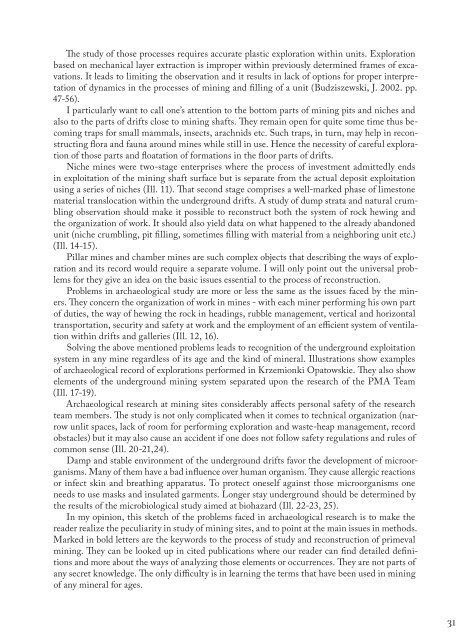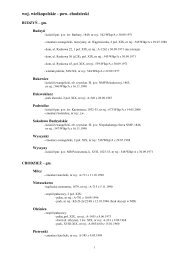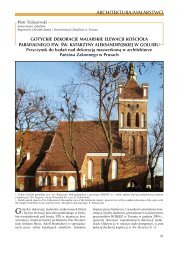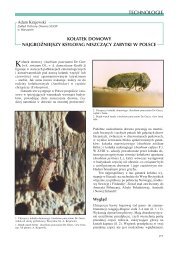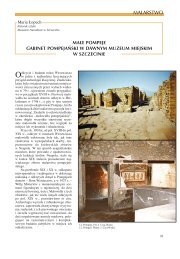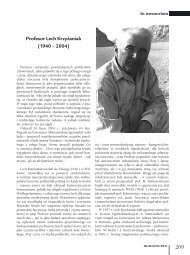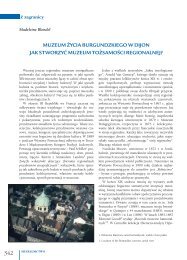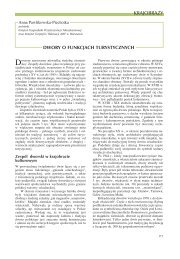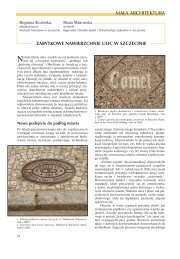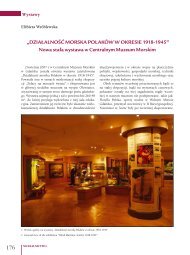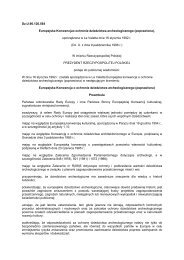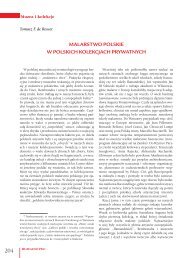Materiały z konferencji konserwatorstwa archeologicznego, 2007
Materiały z konferencji konserwatorstwa archeologicznego, 2007
Materiały z konferencji konserwatorstwa archeologicznego, 2007
You also want an ePaper? Increase the reach of your titles
YUMPU automatically turns print PDFs into web optimized ePapers that Google loves.
The study of those processes requires accurate plastic exploration within units. Exploration<br />
based on mechanical layer extraction is improper within previously determined frames of excavations.<br />
It leads to limiting the observation and it results in lack of options for proper interpretation<br />
of dynamics in the processes of mining and filling of a unit (Budziszewski, J. 2002. pp.<br />
47-56).<br />
I particularly want to call one’s attention to the bottom parts of mining pits and niches and<br />
also to the parts of drifts close to mining shafts. They remain open for quite some time thus becoming<br />
traps for small mammals, insects, arachnids etc. Such traps, in turn, may help in reconstructing<br />
flora and fauna around mines while still in use. Hence the necessity of careful exploration<br />
of those parts and floatation of formations in the floor parts of drifts.<br />
Niche mines were two-stage enterprises where the process of investment admittedly ends<br />
in exploitation of the mining shaft surface but is separate from the actual deposit exploitation<br />
using a series of niches (Ill. 11). That second stage comprises a well-marked phase of limestone<br />
material translocation within the underground drifts. A study of dump strata and natural crumbling<br />
observation should make it possible to reconstruct both the system of rock hewing and<br />
the organization of work. It should also yield data on what happened to the already abandoned<br />
unit (niche crumbling, pit filling, sometimes filling with material from a neighboring unit etc.)<br />
(Ill. 14-15).<br />
Pillar mines and chamber mines are such complex objects that describing the ways of exploration<br />
and its record would require a separate volume. I will only point out the universal problems<br />
for they give an idea on the basic issues essential to the process of reconstruction.<br />
Problems in archaeological study are more or less the same as the issues faced by the miners.<br />
They concern the organization of work in mines - with each miner performing his own part<br />
of duties, the way of hewing the rock in headings, rubble management, vertical and horizontal<br />
transportation, security and safety at work and the employment of an efficient system of ventilation<br />
within drifts and galleries (Ill. 12, 16).<br />
Solving the above mentioned problems leads to recognition of the underground exploitation<br />
system in any mine regardless of its age and the kind of mineral. Illustrations show examples<br />
of archaeological record of explorations performed in Krzemionki Opatowskie. They also show<br />
elements of the underground mining system separated upon the research of the PMA Team<br />
(Ill. 17-19).<br />
Archaeological research at mining sites considerably affects personal safety of the research<br />
team members. The study is not only complicated when it comes to technical organization (narrow<br />
unlit spaces, lack of room for performing exploration and waste-heap management, record<br />
obstacles) but it may also cause an accident if one does not follow safety regulations and rules of<br />
common sense (Ill. 20-21,24).<br />
Damp and stable environment of the underground drifts favor the development of microorganisms.<br />
Many of them have a bad influence over human organism. They cause allergic reactions<br />
or infect skin and breathing apparatus. To protect oneself against those microorganisms one<br />
needs to use masks and insulated garments. Longer stay underground should be determined by<br />
the results of the microbiological study aimed at biohazard (Ill. 22-23, 25).<br />
In my opinion, this sketch of the problems faced in archaeological research is to make the<br />
reader realize the peculiarity in study of mining sites, and to point at the main issues in methods.<br />
Marked in bold letters are the keywords to the process of study and reconstruction of primeval<br />
mining. They can be looked up in cited publications where our reader can find detailed definitions<br />
and more about the ways of analyzing those elements or occurrences. They are not parts of<br />
any secret knowledge. The only difficulty is in learning the terms that have been used in mining<br />
of any mineral for ages.<br />
31


